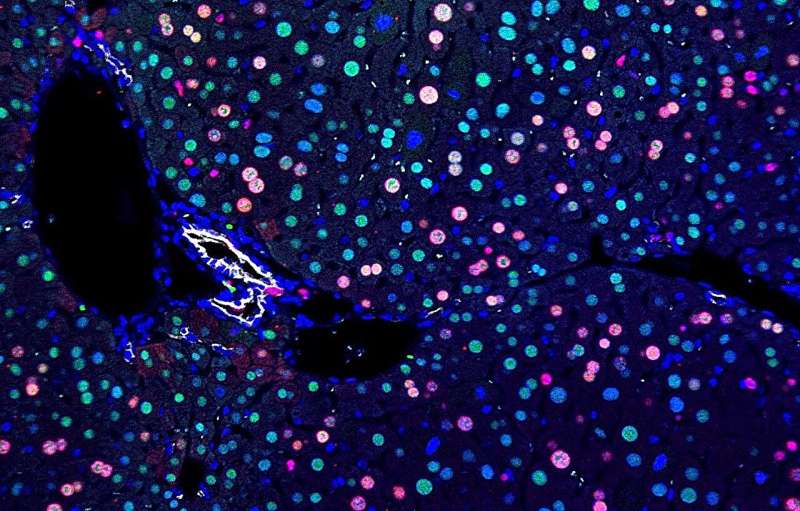This article has been reviewed according to Science X's editorial process and policies. Editors have highlighted the following attributes while ensuring the content's credibility:
fact-checked
peer-reviewed publication
trusted source
proofread
Study identifies metabolic inflexibility that keeps damage at bay during liver regeneration

Liver cells have a vital metabolic inflexibility during regeneration to starve dysfunctional cells and keep damage from spreading, according to new research from Children's Medical Center Research Institute at UT Southwestern (CRI) published in Science.
CRI Associate Professor Prashant Mishra, M.D., Ph.D., Xun Wang, Ph.D., and colleagues have found that hepatocytes, the cells responsible for most liver function, normally use their mitochondria to process fatty acids, a key energy source during regeneration. When their mitochondria are damaged, hepatocytes turn on PDK4—a metabolic enzyme that restricts cells from shifting to an alternative energy source—and cells die.
"There are good and bad sides of metabolic flexibility. Although metabolic flexibility has been largely described as beneficial because it gives cells the ability to tolerate shifting environments or alternative nutritional sources, our findings suggest flexibility can also be detrimental by allowing damaged cells to survive," Dr. Mishra said. "With mitochondrial damage, liver cells actively suppress flexibility—a good thing if it prevents the damage from spreading."
CRI scientists initially studied the mitochondria of healthy liver cells, both under normal and regenerative conditions. Their analyses showed fatty acids from other parts of the body were transported through the blood to the liver to fuel regeneration. When researchers blocked fatty acid transit, healthy livers were flexible and shifted to other energy sources, including sugars like glucose.
Researchers then examined livers from mice with mutations in their mitochondrial genes. Damaged liver cells were unable to use fatty acids during regeneration and did not shift to other energy sources, preventing livers from regenerating.
To understand why the flexibility was suppressed by mitochondrial mutations, Mishra Lab members examined genes that control a cell's ability to use alternate energy sources. Results showed increased levels of the PDK4 gene—a negative regulator of a pathway needed to generate energy from glucose. When researchers blocked PDK4, damaged cells in the liver became metabolically flexible and were able to use other energy sources to spread and duplicate.
"The liver has an amazing capacity to regenerate after injury, but it is important that only the healthy cells multiply. We found that metabolic inflexibility can be useful by eliminating unhealthy cells," Dr. Mishra said.
Previous Mishra Lab research showed that healthy mitochondria are critical in the liver for proper organ function and fatty acid metabolism. This new research illustrates how regenerating livers regulate cell proliferation and how disabling the key regulator PDK4 results in unhealthy livers with fat accumulation and steatosis, also commonly known as fatty liver disease.
"Mitochondrial damage is often observed in common human diseases, including cancer," Dr. Mishra said. "We hope that by identifying the mechanisms cells use to prevent damage from spreading, we can harness these processes to potentially combat disease and prolong health."
More information: Xun Wang et al, Metabolic inflexibility promotes mitochondrial health during liver regeneration, Science (2024). DOI: 10.1126/science.adj4301





















